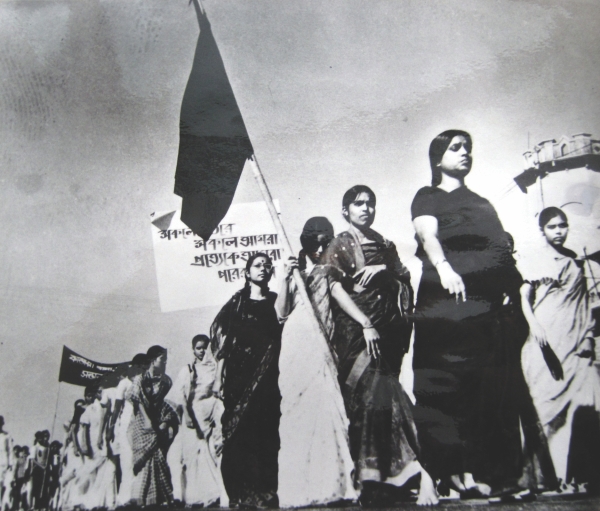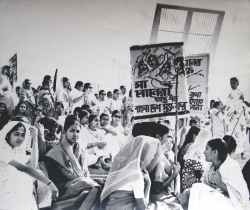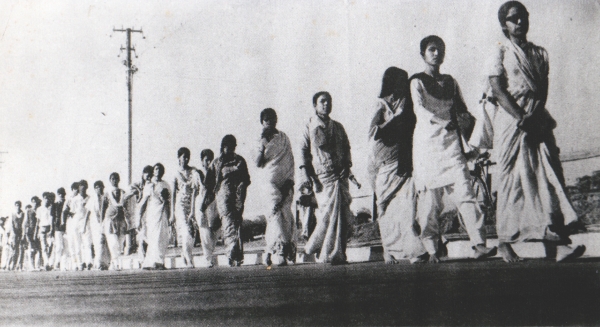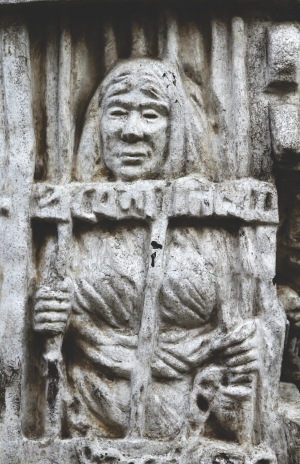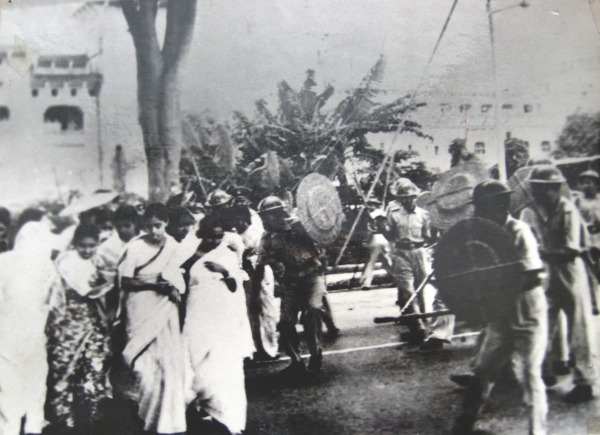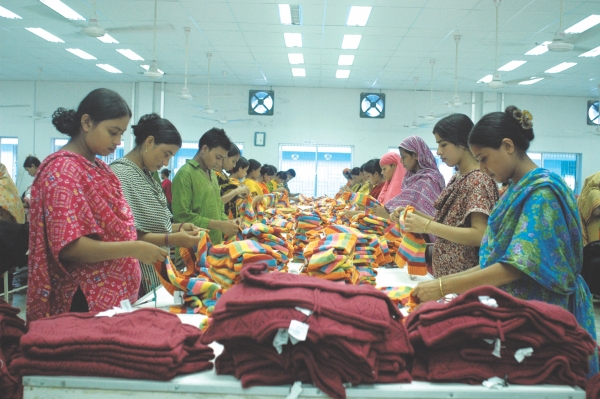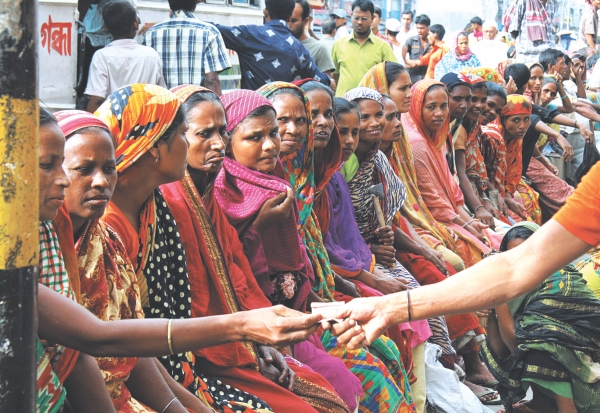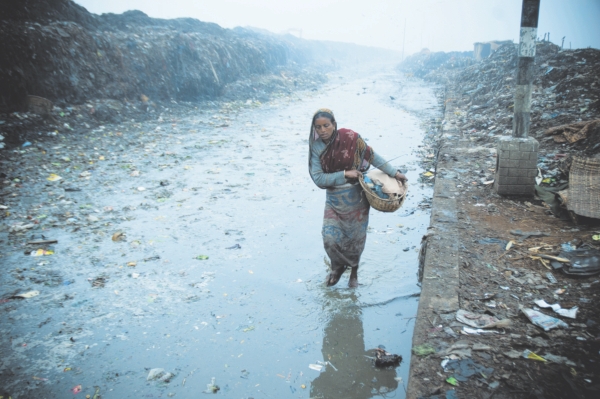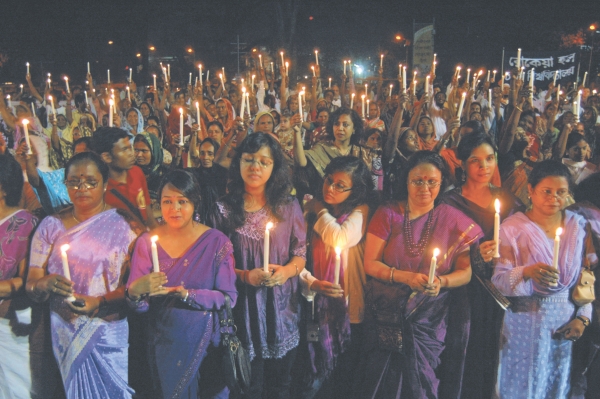| Home - Back Issues - The Team - Contact Us |
 |
| Volume 11 |Issue 10| March 09, 2012 | |
|
|
Cover Story
The Movement Forward Sushmita S Preetha History is a word that makes an ordinary person feel removed from the events captured. This particular history, however, or perhaps we should call it herstory, is not a distant one, nor is it removed from your own experiences. It happened around you, to you. And maybe you were a part of it without even realising it, every time you demanded that a woman be taken as seriously as a man, protested the ongoing violence against women or stood up against a colleague's chauvinistic opinions. Whether we realise it or not, the ethereal yet tangible thing called the women's movement in Bangladesh has had an impact on all our lives, albeit in different degrees and different forms. Over the years, the movement has grown, changed, diversified, institutionalised itself, but it has not abandoned its overarching objective of ensuring women's equal participation in economic, social, civil and political spheres. The Awakening
In a way, the autonomous women's movement in Bangladesh was conceived long before Bangladesh was born, in the actions of strong women like Roquia Sakhawat Hossain, who dared to defy patriarchal and unjust norms. Since then, progressive women in successive generations have sought to carve out a vision of a different world, free of discrimination and injustice. In Bengal, women played an important role in challenging British rule, as well as in protesting the communal violence in the region. They participated in the Tebhaga Movement in 1948, Language Movement in 1952 and the mass upsurge of 1969 alongside men, gradually creating a space for themselves in the political arena. “Even if at that point, there wasn't a cohesive and focused movement, I consider all these struggles by women as a part of the women's movement,” says Khushi Kabir, activist and chairperson of Nijera Kori, highlighting that women like Ila Mitra, Hena Das and Sufia Kamal were at the forefront of many of these movements.
The East Pakistan Mahila Parishad (later renamed the Bangladesh Mahila Parishad) was formed in 1970, backed by the Communist Party, under the leadership of Sufia Kamal. It was the first organisation of its kind to look at women's concerns from an activist point of view, creating a forum for women from different backgrounds to engage with the most pressing issues of the day. Formed in the wake of the liberation war, Mahila Parishad played an active role before, during and after 1971. During 1971, women from all walks of life joined the struggle for independence as fighters, informants, weapons suppliers, cultural activists and so on. Hundreds of thousands of women were subjected to mass rape and associated consequences, psychological trauma and displacement, along with the destruction of their homes and livelihoods and the loss of family members. Immediately after the war, two organisations were formed, Bangladesh Mahila Samity and Nari Punarbashan Kendra to rehabilitate and integrate survivors of rape, although the state never adequately addressed the plight of the survivors. The women's movement at that time had a close relationship with the socialist movement, and many leftist parties began to form women's wings. Sultana Kamal, human rights activist and chairperson of Ain O Shalish Kendra, argues, “In other countries around the world, there have been sharp divisions between the two movements, but in Bangladesh, where most women's rights activists were also involved with the socialist parties, there hasn't been any serious drifts.” As a result, when we look at the constitution, we see socialism as a basic tenet as well as find very important clauses for the protection of women, explains Kamal.
The struggle for liberation gave many women, who had been active and resourceful during the war, the courage to break free from hitherto accepted notions. “There were more women working and going out than ever before; women became involved with theatre and other performance arts, and we also think we had a stronger feminist perspective and ideology at that time,” recalls Kabir. Working with NGOs at the grassroots level gave many urban women a better perspective on the condition of rural women and enabled them to form a more critical approach to feminism. “These changes enabled the women's movement to grow from one or two organisations to a larger movement of women,” adds Kabir. By the mid 1970s, the movement was well underway.
The Decade of Darkness Shireen Akhtar, the founding President of Karmojibi Nari and a member of Jatiyo Samajtantrik Dal, states that the autocratic Ershad regime, in particular, pushed the women's movement to redirect its energies towards democratisation. “Democracy, for women, had a special implication. Fighting for democracy meant challenging the tyranny and autocracy of male-dominated values of the family, workplace and the state. A woman had to fight for her civil and political rights at the same time that that she had to fight against her colleagues, husband, brother or father,” opines Akhtar. In the anti-autocracy movement against Ershad, a large number of women joined other civil society allies in overthrowing military dictatorship and establishing multi-party democracy.
From Emancipation to Empowerment In the ensuing period of market-led growth and NGO-driven development activities, there were many heated discussions about women's wages and working conditions; but in the end, the economic exploitation of women in low-paying jobs was never adequately addressed. Shameem Akhtar, feminist filmmaker and activist, argues, “Yes, there were trade unions, but they refused to acknowledge that women's issues in the workplace needed to be highlighted separately. Meanwhile, urban middle class women were more focused on ensuring their own rights than in working on issues like better pay, maternity leave, gender sensitive work areas and sexual violence in the workplace.” Similarly, Shireen Akhtar, who has been working with women workers for a long time, asserts that trade unions, trade bodies, different professions, including electronic media and journalism, still remain predominantly patriarchal spaces. “An equal and classless society cannot be achieved as long as women are discriminated against; similarly, it's not enough for feminists to talk solely about rights when women's subordination is so clearly linked to economics and politics,” says Shireen. “We have to fight the economic as well as the patriarchal system simultaneously.” Interesting to note is the fact that women's entry into the labour market happened around the same time as the NGO boom in service delivery and population control, marked in the global arena by a paradigm shift to the right. Instead of dealing with class and structural inequalities, many big developmental NGOs began to use new sexy catchphrases like 'women's empowerment', arguing that empowerment could be achieved by improving the access of poor women to credit. However, as Irene Khan, prominent human rights activist, states, “Gender inequality is not a product of scarcity. So, while investing more resources in service delivery and creating more opportunities can and do have a positive impact on women's lives, they are not in themselves enough to address the root causes of women's empowerment.” These programmes treat the symptoms, rather than the disease. Following the lead of these big NGOs, and love-struck by donor money, many previously movement-oriented women's rights NGOs began to embrace the top-down approach to empowerment. They now conceived of women's rights in terms of projects, budget proposals, seminars and workshops. Smaller NGOs mushroomed all over the country, employing magic mantras like 'gender mainstreaming,' 'capacity building trainings,' and 'service delivery' to receive funding for their projects. Of course, many of these NGOs had no option but to fall prey to these trends as they were dependent upon donor money for survival. Even the most progressive of NGOs have to be accountable to a higher western power in some form or the other. That does not, however, necessarily undermine or take away their enormous contributions in promoting the rights of women and other minority groups over the years. As Sultana Kamal says, “There is a limitation to NGOs that they have to abide by certain rules and regulations, but even operating within a particular structure, NGOs have done a lot of great work on women's issues.” Among an exhaustive list, NGOs have worked to ensure civil, political, social and economic rights spearheaded programmes on poverty alleviation, formal and non-formal education, health, family planning, agriculture, water supply and sanitation, human rights and advocacy, legal aid and so on.
According to Maleka Begum, women's rights activist and faculty member of Women's and Gender Studies, Dhaka University, as a result of the rapid expansion of NGO activities from the 1980s onwards, crucial networks have been established between grassroots women and urban women. NGOs have influenced the lives of many rural women in remote areas, enabling them to challenge patriarchal norms and traditions. She notes, however, that although many elements of the women's movement are present at the village and district levels, it is no longer as visible or vibrant as it once was. In the capital, the women's movement plays an integral role in lobbying for progressive laws and policies, conducting advocacy with powerful stakeholders, forming coalitions to resist fundamentalist forces and violence against women, but there is a growing disconnect between grassroots and national-level activists, argues Begum. The relationship between NGOs and the women's movement has been a complex and dynamic one. What began as love-at-first-sight has perhaps turned into a committed long-term relationship – a little too comfortable. Maheen Sultan, a researcher at BRAC Development Institute, says, “There used to be a sharper distinction between developmental NGOs and feminist organisations when the latter were more based on voluntarism, driven by a philosophy and political ideology. Gradually even feminist organisations have started taking on NGO structures and processes with paid staff, for example, but the best of them still maintain their vision and independence of agenda.” She feels that organisations that are for women by women and that seek to explore and articulate women's positions and demands will at some level be different from NGO based women's rights work. However, in order to bring about change on a larger scale, the feminist movement needs to establish allies with, and influence, the NGO based women's rights workers, not be subsumed by them. The women's movement in Bangladesh has always been a thriving force for progressive change. Even though the movement right now is a fragmented one, with different strains focusing on different issues, it comes together from time to time to show its solidarity with the women of Bangladesh and to protest grave injustices. One recalls, for instance, the Yasmin case of 1995, when a 14-year-old girl was raped and murdered by three police men, or the Noorjahan fatwa case of 1993, when Noorjahan, after the humiliation of being stoned, committed suicide, or the Kalpana Chakma abduction. More recently, the women's movement protested the rape at Jahangirnagar and the brutal harassment of Rumana. In all these instances, the power of the women's movement was apparent. Collectively, the women's movement is an unstoppable force, but it's not always easy to get the different groups together under one overarching cause. The 'Woman' Question
Irene Khan argues that the feminist movement in Bangladesh is a product of the urban upper middle class and is led by them. “Poor rural (and urban) women's struggle for survival is an alien experience for urban educated women. Even though feminist leaders are trying, I cannot say there is a true 'nationwide' feminist movement,” says Khan. “If I was being cynical, I'd say feminism - as understood internationally - is a luxury in Bangladesh for the better-off women. So the biggest challenge for the feminist movement is to overcome those barriers of class, wealth and geography (rural/urban).” Maheen Khan, a younger feminist, believes that the feminist movement has matured and developed and that its understanding of itself has also changed. She says, “A garments worker fighting for her rights is as much of a feminist as a woman involved in a struggle for khas land, when she realises the gender dimensions of her discrimination and struggle.” She argues that the older generation has sought to address the criticism of its middle class identity, and incorporate the demands and aspirations of diverse groups of women. “There is a greater understanding of the diversity of women's realities and an increasing respect for differences. The slogan of 'let a thousand flowers bloom' does have a definite resonance in the feminist movement,” she adds.
Meanwhile, Hana Shams Ahmed, a young human rights activist, thinks that in recent times, the movement has moved itself into a comfortable zone, with certain issues as their blind spot. She says, “The rights of sex workers and homosexual women, for example, are not taken seriously because many people still stigmatise sex work, and homophobia is culturally so congenital that we prefer to look the other way. These are some of the areas that feminists need to work on as well, concerns they have neglected.” She argues that it is very important for us as individuals to question our own prejudices. “Too often, we just want to fight against discrimination and sexism from within a cocoon of comfort built by ourselves. That kind of comfort zone is self-defeating,” she opines. The women's movement is not a homogenous one – it is made up of people and groups with disparate identities. It doesn't belong to anyone any more than the sky belongs to men. But one must not ignore the hierarchies that do exist within the movement. After all, we do not want to reproduce the same inequalities that we seek to dismantle.
|
||||||||||||
Copyright
(R) thedailystar.net 2012 |
